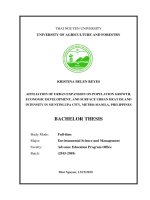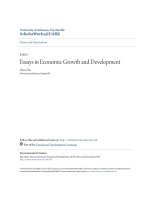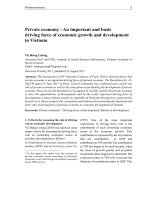Economic growth and economic development 710
Bạn đang xem bản rút gọn của tài liệu. Xem và tải ngay bản đầy đủ của tài liệu tại đây (65.07 KB, 1 trang )
Introduction to Modern Economic Growth
technical change. Nevertheless, neither Habakkuk nor the induced innovation provided any micro-founded model of technological change or technology adoption. For
example, in Kennedy’s specification the production function at the firm level exhibited increasing returns to scale because, in addition to factor quantities, firms could
choose “technology quantities,” but this increasing returns to scale was not taken
into account in the analysis. Similar problems are present in the other earlier works
as well. It was also not clear who undertook the R&D activities and how they were
financed and priced. These shortcomings reduced the interest in this literature, and
there was little research for almost 30 years, with the exception of some empirical
work, such as that by Hayami and Ruttan (1970) on technical change in American
and Japanese agriculture.
The analysis in Acemoglu (1988) and the subsequent work in this area, instead,
starts from the explicit micro-foundations of the endogenous technological change
models discussed in the previous two chapters. The presence of monopolistic competition avoids the problems that the induced innovations literature had with increasing returns to scale.
Acemoglu (2002 and 2003b) show that the specific way in which endogenous
technological change is modeled does not affect the major on the direction of technological change. This is also illustrated in Exercises 15.19 and 15.29. In addition,
even though the focus here has been on technological progress, Acemoglu (2007)
shows that all of the results generalize to models of technology adoption as well.
Acemoglu (2007) also introduces the alternative concept of weak absolute bias and
strong absolute bias, which look at the marginal product of a factor rather than
relative marginal product. He shows that there are even more general theorems on
weak and strong absolute bias. We sometimes referred to weak relative bias and
strong relative bias to distinguish the results here from the absolute bias results.
Changes in the US wage inequality over the past 60 years are surveyed in Katz
and Autor (1999), Autor, Katz and Krueger (1998) and Acemoglu (2002b). The
latter paper also discusses how models on directed technological change can provide
a good explanation for changes in wage inequality over the past 100 years and also
changes in the direction of technological change in the US and UK economies over
the past 200 years. There are many studies estimating the elasticity of substitution
696









